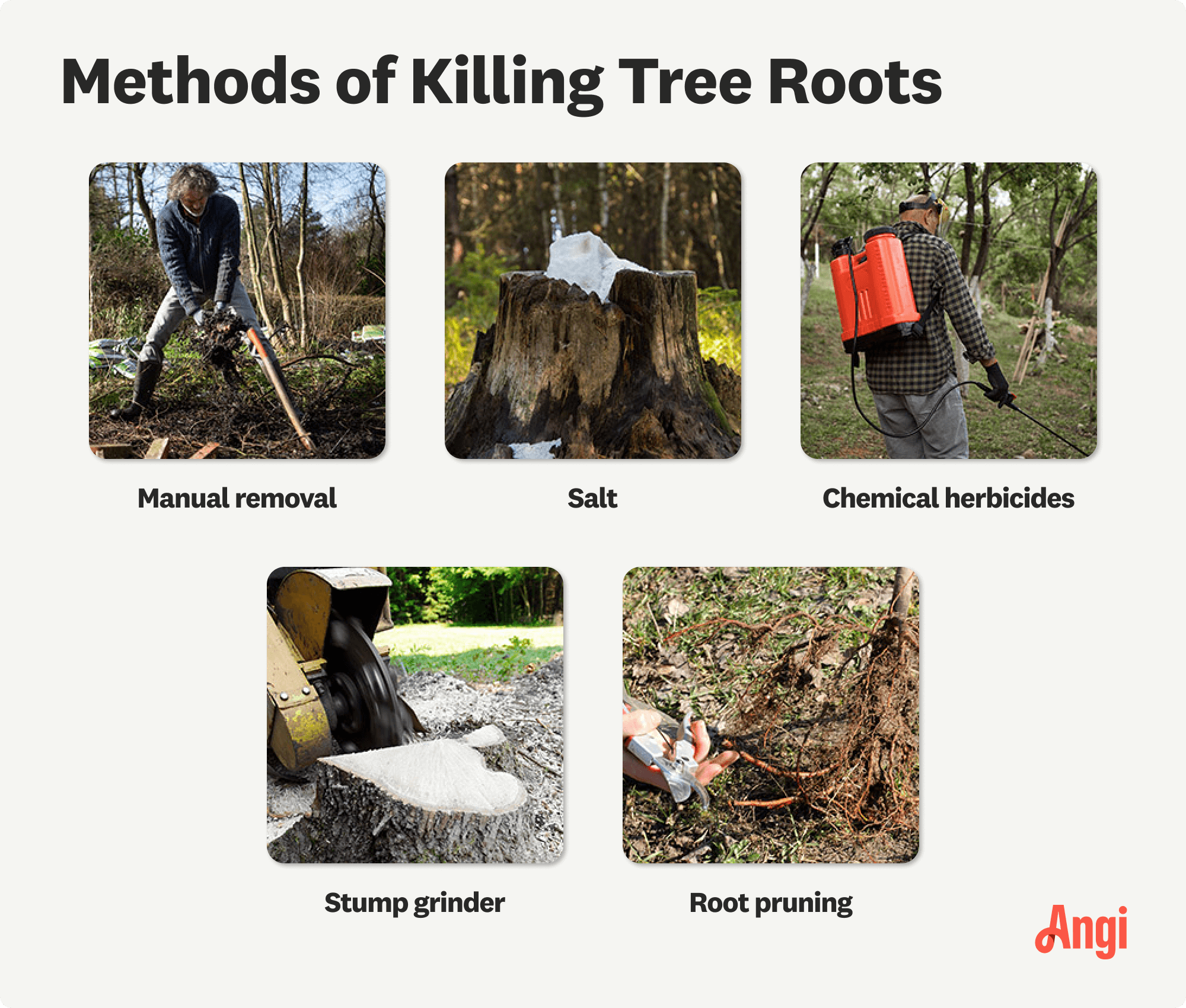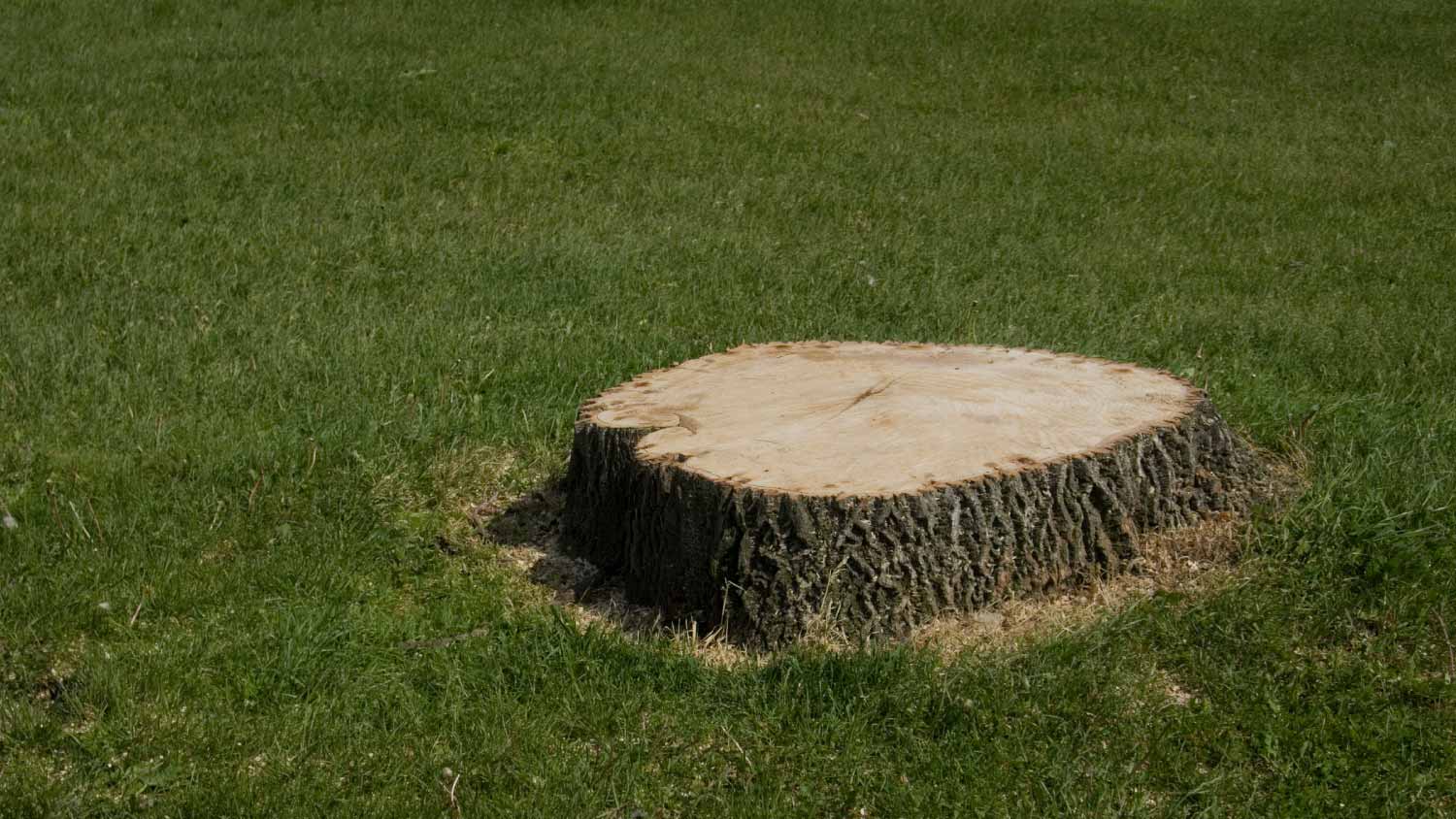
The cost of tree stump removal depends on size, removal method, location, and more. Our guide will show you how much stump removal costs.
Don’t let these stragglers uproot your home


Tree root removal costs between $100 and $200, but a professional can finish the job more quickly and safely than most DIY attempts.
Removing tree roots requires specialized tools and safety precautions, making it a risky undertaking for homeowners without the right experience.
A local tree maintenance pro is especially worth hiring if roots have invaded your plumbing, damaged your foundation, or pose other structural hazards.
Before saying goodbye to a tree in your yard, you need to learn how to stop tree roots from growing back. The truth is, tree roots can and will keep growing if you don’t take the time to eradicate them during the tree removal process. Let’s review exactly what to do to stop tree roots from growing back—no matter what kind of roots you’re dealing with or how long they’ve given you grief.

Before attempting heavy-duty methods, start the root removal process with gentler materials. Homemade solutions can be nearly as effective as chemical herbicides without the negative impacts—like killing neighboring plants. However, these methods may take longer, so if you want quick results, you may want to use chemical herbicides.
For each one of these homemade methods, make sure to have a drill handy to make holes in the stump or over-ground roots.
Drill several holes into what’s left of the stump and roots, between 3 and 4 inches deep. You’ll also want to drill several holes into any large, over-ground roots.
Fill each hole to the brim with Epsom salt. Don’t let the salt overflow, especially if you have other plants nearby.
Repeat step two every few months until all the roots are dead. You’ll know that they’ve stopped growing when the remaining roots are hollow and wilted, and you don’t see any new sprouts near or on the trunk.
Dig up and expose as many roots as possible.
Use a chainsaw to cut the stump as close as possible to the roots for the best effect. (Note, stop when it’s still a few inches high, as this will fall into the “kickback zone” for chainsaws and can cause injuries.)
Drill several holes into the stump between 3 and 4 inches deep. Do the same for large roots that have grown over the ground.
Carefully cover as many roots as possible with boiling water. This technique will immediately damage and shock the root system, but you still might not see any noticeable changes right away. Check back in a few days later and repeat this step if nothing has changed.
Use a shovel to dig up and expose as many roots as possible.
Drill holes into the remaining stump and large roots and fill to the brim with vinegar.
If sprouts or leaves appear on the remaining stump, spray them with vinegar as they pop up.
If the roots haven’t died after a month of soaking in vinegar, keep repeating step two every month until they do. If you’re still not having any luck after several months, it may be time to try out a new method.
Cut the stump as close as possible to ground level with a chainsaw (without getting into the “kickback zone,” and expose as many roots as you can with a shovel.
Apply chemical herbicide with a spray can or paintbrush. Make sure that all the roots and remaining stump are fully coated, and avoid splashing herbicides on any other plants nearby.
Retreat roots with herbicide if they haven’t died in two to three weeks.

Manually removing roots is a good option if you have smaller roots in your yard or if you have already applied one of the methods above and need to remove any remaining roots.
Here’s everything you may need to dig them out with success:
Reciprocating saw
Drill
Shovel
Garden hoe
Remove as much soil as possible from what remains of the tree stump and the root system. The roots will be easier to remove either by hand or machine when they are less compacted by dirt.
Treat the roots with a homemade remedy, store-bought root killer, or herbicide to weaken them. When these solutions have had a chance to soak in and do their magic—after a few weeks to a month—manually removing the roots will be much easier.
Use a reciprocating saw to cut away larger roots. Use similar safety precautions that you would when using a chainsaw, including wearing long sleeves and pants, and standing solidly on two feet at all times.
You can also use a hatchet if you’re more comfortable, though this will be more strenuous. Make sure the head of the hatchet is firmly attached to the handle, and that the handle doesn’t have any splits or cracks that may break while you work. Plant feet firmly on the ground about hips-width apart and grip the handle with both hands. As you begin, always swing the hatchet away from your body.
If using a hatchet, strike the stump or roots in alternating right and left motions to create a V-shaped cut, which will make it easier to break down.
Always stop to take a break when you feel yourself becoming fatigued. Accidents are more likely to happen if you’re tired.
If you’re working with a particularly large root, start at the farthest point from the stump and work your way inward so you don’t have to remove an entire root all at once.
When the large roots are all gone, dig up the remaining small roots with a shovel or garden hoe.
Root barriers will keep roots from returning. This material is available in various materials, including metal, concrete, and plastic. To install:
Measure three times the trunk's diameter to estimate where you’ll dig to place the root barrier.
Measure the length of coverage using the barrier panels or cloth.
Once you know how much barrier you’ll need, dig a 30-inch deep trench about 3 to 4 inches wide to accommodate your barrier.
Slide the barriers into the trench, making sure the top barrier is above ground by an inch to keep the roots from growing over it.
Backfill the area.

Although you can definitely remove tree roots on your own with the right equipment, safety precautions, and enough patience, there are a couple of instances when you might be better off leaving it to a local tree maintenance pro. If the roots have penetrated your plumbing system, are posing a risk to the structural integrity of your home, or are simply too large to remove by yourself, you are much better off outsourcing the project to an expert. Similarly, if you’re not confident using power tools like a chainsaw or applying chemical herbicides, consider letting a pro do it for you instead.
The cost to remove tree roots depends on the method (or multiple methods) you use and whether or not you decide to outsource the project to a professional landscaper in your area or a tree removal pro near you. The cost of materials to do it yourself ranges from $15 to $50, whereas a pro will charge between $100 and $200 for all of the labor and supplies involved.
Some, but not all, tree roots will continue growing even after the tree has been cut down or, in some cases, even after a stump has been removed. If the remaining roots have no sprouts or leaves to accumulate energy to keep growing, the roots will eventually die.
But if you see sprouts popping up on large, leftover roots, they’re likely to continue growing and wreaking havoc on your lawn, especially bamboo roots. Knowing how to stop tree roots from growing back will allow you to nip the problem in the bud (literally!), so you don’t have to worry about any leftover roots causing structural damage to your home in the long run.
You’ll need to properly fill the hole to prevent root regrowth. Follow these steps:
You can use rocks, which will keep the root from returning as there will not be enough soil. Concrete is another option, although it is a more considerable investment.
Once the hole is filled, cover the area with grass or flowers. This step can keep the soil in place to prevent erosion, prevent weed growth and balance moisture levels.

Overgrown roots pose numerous risks to both outdoor and indoor spaces—from minor issues like uprooting your pavers to larger ones like causing structural damage to your home’s foundation. Even if the tree is no longer standing, these pesky remains can and will keep growing without proper removal.
Although it’s best to remove the tree and roots all at once, there are a couple of instances where you may have to remove older roots that have been in the ground for a while. Maybe you moved into a new home and began landscaping or found roots from a long-gone tree causing problems in your sewage line. Fortunately, you can use the same removal methods to stop the growth of almost any kind of root once and for all.
There are several warning signs of tree root damage that you should keep in mind during your next tree inspection. Look for the following signs:
Tree bark peeling
Dead tree roots
Tree fungus
Foul odor from tree
Leaning tree
Wilting leaves
From average costs to expert advice, get all the answers you need to get your job done.

The cost of tree stump removal depends on size, removal method, location, and more. Our guide will show you how much stump removal costs.

Trimming your bushes is one of the less costly aspects of landscaping, and it’s helpful to bundle many trimming services together to save money.

Discover the average tree maintenance cost, key price factors, and tips to save. Get expert insights to plan your tree care budget with confidence.

Arborists define Dutch elm disease as one of the most destructive diseases a tree can catch. Here’s what you can do—from spotting symptoms to treatment.

Cabling and bracing trees may help to increase longevity and prevent limbs from falling when trees are showing certain signs of distress.

Are surface roots a problem? Maybe not, but if an issue does crop up, it could be costly. Here’s what to do when you notice tree roots in your lawn.